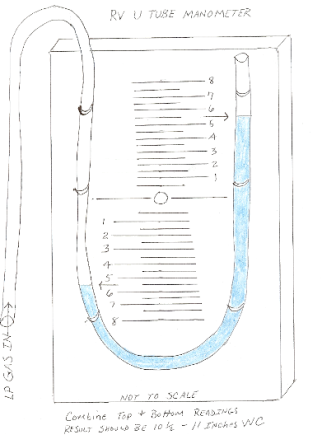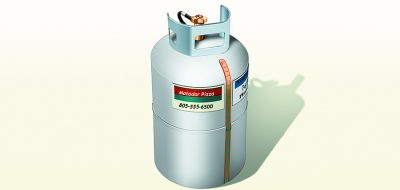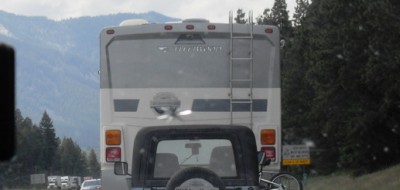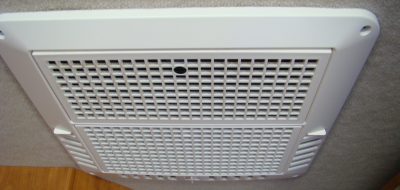
Every once in a while I’ll get asked a question about the LP gas operating pressure for RV gas appliances, or about checking the LP gas system for leaks. I usually explain that you should have a LP gas operating pressure test and a leak test performed by an authorized RV service center at least annually, and anytime the LP gas system is worked on. The reason I recommend this is because RV service centers have trained technicians with the proper equipment to perform these tests.
Most RVers don’t purchase test equipment like a manometer, used to perform LP gas pressure and leak tests. The cost of some test equipment makes it prohibitive, and the thought of only using it on an annual basis makes buying it kind of pointless. But if you did in fact have a manometer the process of testing the LP gas system is not that difficult.
Note: If you are not comfortable working around LP gas, or don’t understand how to properly use LP gas test equipment have all testing done by an authorized RV service center.
What does 11 inches of water column mean?
There are several different types of manometers available for testing the RV LP gas system pressure, but the most accurate type is what is referred to as a U tube water column manometer. A water column manometer measures the LP gas operating pressure in units of water column inches. You add water to the manometer until the water on both sides of the U shaped tube register evenly at zero on the scale. When you apply the LP gas pressure to the manometer, (usually by removing and connecting the hose to one of the range top burners and turning the burner gas supply on), the gas pressure will force the water down the tube on one side and up the tube on the other side.
Note: Light one of the other range burners to ensure the LP gas is turned on and there is a steady flow of gas to the range top.
Now you combine the measurements, in half inch increments, that the water dropped from zero on one side of the tube and raised from zero on the other side. This total measurement represents the inches of water column pressure. For RV appliances to operate properly, and safely the operating pressure should be 10 ½ to 11 inches of water column.
On an RV the LP gas pressure is regulated by a two stage regulator. The job of the first stage is to regulate the vapor pressure coming out of the container, which can be as high as 250 psi, down to 10 psi or less. The second stage takes that already lowered vapor pressure and regulates it down to the 11 inches of water column operating pressure. The reason for using a manometer to test this pressure is that the operating pressure for LP gas appliances is extremely low if measured in pounds per square inch; somewhere in the neighborhood of .5 psi.
If the LP gas operating pressure is too high or too low you can adjust it at the RV regulator. To do this remove the plastic cap on the front of the regulator and you will see the adjusting screw. If the water column pressure is less than 11 inches you can increase it by turning the adjustment screw clockwise. If it’s more than 11 inches you can decrease it by turning the adjustment screw counterclockwise. Always turn the adjustment screw slowly, and make sure a range burner is lit when making adjustments to the regulator. Adjust the regulator until the readings on both sides of the U tube manometer equal 11 inches of water column.
Happy Camping,
Mark Polk







JB Fite
Dear Mr. Polk,
When at the dealership, my gas appliances work fine. When I go camping in the mountains (at 9000 to 10,000 feet above sea level) my gas heater and refrigerator act up. I suspect that this is due to the lower ambient pressure allowing too much gas flow through the jet which then causes an unstable flame capable of extinguishing itself. Can you please help me with this?
Thank you for your excellent articles.
JB
Milton
My Dometic fridge LPG burner wouldn’t ignite at high altitude (6K feet and above).
Dometic support recommended adjusting to 12 WC inches. Does this jibe with your experience?
Thanks
Dave
The U Tube worked well and took me 5 min to build. I found 8WC and replaced the regulator. My LP On Demand Bosch works great now. TY
Richard Sullivan
I am having a problem with my automatic change over on my new regulator. It will not change over to the reserve tank when the primary tank is emptied.
Can this be due to the regulator not being set right ?
Hydrogen Leak Testing
I think this is a great post. You described all the thinks really well. I would love to read your next post. Thank you.
Mark Polk
Chris,
Thanks for making the point about the range having its own regulator. This is one of those articles where you’re not sure where to stop writing and it’s one of the reasons I recommend letting an RV service center test and adjust the LP gas operating pressure.
Nowadays, as Chris mentioned, gas ranges have their own regulator, (If you have an older RV your range may not). On a range with a regulator you will need to turn the gas supply off and disconnect the gas line fitting where it goes into the range regulator. At this point you will need to make some sort of adapter, made up of flare fittings and copper tubing, to go from the flare nut on the gas line you disconnected from the regulator to the plastic tubing on the manometer.
When all of fittings on the adapter are tight and the manometer is connected to the gas line adapter you can turn the gas supply back on. At this point you will want to light the other LP gas appliances in the RV to get an accurate reading. If the manometer reading is less than 10 1/2 or more than 11 inches of water column you will want to adjust the regulator as described above.
Something else to keep in mind is that anytime you break into the LP gas system you need to check the system for leaks. After re-connecting the gas line to the range regulator you can check it for leaks with an approved leak detector solution (purchased from an RV dealer) or test for leaks using the manometer. But that’s a whole other article.
So, unless you want to buy or build your own U tube manometer, and make an adapter for pressure testing the system you can see why I recommend having LP gas pressure and leak tests performed by a qualified RV service center.
Chris Bryant
As always, a great post.
One caveat though- you really cannot adjust the regulator by hooking up to the range, because ranges have their own regulators built in which are normally set at around a 10″ water column.
Thomas Becher
Good easy advise. I like it when someone advises someone to to something for themselves. You get to learn and it saves you money and you probably get thing done right. I put a permanent guage on my system(with a ball valve shut off) so I can look at mine any time. Those regulators can and do go bad, and once a year checking it I don’t believe is enough.